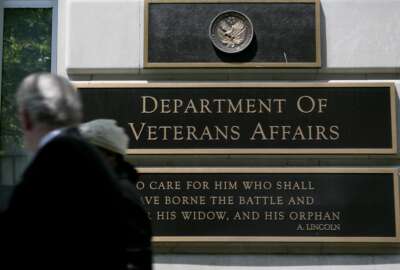Federal workforce attrition rises back up to pre-pandemic levels
After a dip in the 2020 governmentwide attrition rate, employees voluntarily left the federal workforce in 2021 at an average rate of 6.1%, often to retire or f...
During a year with uncertainty over office reentry plans and a presidential transition, the percentage of employees who left the federal workforce in fiscal 2021 increased, now aligning with pre-pandemic attrition trends.
After a dip in the 2020 governmentwide attrition rate, employees voluntarily left the federal workforce in 2021 at an average rate of 6.1%, often for reasons like retiring or finding a new job. The percentage was higher than last year’s rate of 5.5%, but on track with 6.1% and 6% in 2019 and 2018, respectively. The report showed a “Great Resignation,” a large wave of employees choosing to leave their jobs, did not happen during 2021, the Partnership for Public Service said.
But despite the overall flat numbers, some agencies and specific sectors of the federal workforce were in a “state of stress,” the Partnership said in an Aug. 2 report on federal workforce attrition rates.
One major factor in attrition rates for agencies was employees’ ages. Employees over 60 had the highest attrition rate, at nearly 17%, with the vast majority of that age group leaving the workforce to retire, the Partnership reported. In fact, more than half of employees who left the federal workforce in 2021 said they left to retire. But, those under the age of 30 also had a significantly high attrition rate at 8.5%, compared with the governmentwide average of 6.1%.
Courtesy of the Partnership for Public Service
The high number comes as some agencies struggle to retain workers and compete with the private sector for younger employees. Just 7% of the federal workforce is currently under the age of 30, while at the same time, 15% of feds are eligible to retire today. The number will double to 30% in the next five years, the Office of Management and Budget reported earlier this year.
Courtesy of the Partnership for Public Service
In the Partnership and Boston Consulting Group’s 2021 Best Places to Work in the Federal Government rankings, though, the results showed that the youngest group of workers ranked highly for employee satisfaction and engagement. Employees who had worked less than a year in the federal workforce were some of the most engaged and satisfied employees, the Partnership said.
The findings suggest those with fewer than five years of federal service may leave their positions for reasons other than frustration with their jobs, the Partnership said. The one exception to the positive scores in the Best Places to Work results was pay satisfaction for the youngest age group, which posted a very low score.
Some specific agencies also showed poor results in attrition trends. The Department of Veterans Affairs, for example, had the highest attrition rate at 7.1%, an increase from its 6.4% rate last year, and 1% higher than the governmentwide average.
“This high attrition rate may be explained by the fact that VA employees served on the front lines during the pandemic, and many are burnt out,” the Partnership said.
Federal workers in the healthcare sector posted the same 2021 attrition rate, 7.1%, as the VA.
At the same time, though, VA was the only large agency to mark an improvement in its employee satisfaction for the 2021 Best Places to Work rankings, compared with its 2020 score. The agency’s satisfaction score rose from 70% in 2020 to 70.2% in 2021, and VA ranked fifth overall among large agencies.
Other agencies with high attrition rates, all at 6.6% and above, were the Departments of Agriculture, Air Force, Army and Treasury.
Courtesy of the Partnership for Public Service
In contrast, the General Services Administration had an attrition rate of 4.2%, the lowest of any agency included in the Partnership’s report, and nearly 2% below the governmentwide average. GSA also showed a decrease in its attrition rate from the previous year, at 4.4% for the agency.
Other agencies that kept their attrition rates very low, at or below 4.5% in 2021, were the Departments of Commerce, Education, State and Transportation, as well as the Environmental Protection Agency, the United States Agency for International Development (USAID) and NASA.
Notably, Commerce and NASA both ranked highly in the 2021 Best Places to Work, with NASA maintaining its number one spot for large agencies for the tenth year in a row, and Commerce ranking third overall for large agencies.
Despite generally low attrition, the majority of agencies posted higher attrition rates in 2021 when compared with 2020. The Defense Department stayed even in its attrition rate, while the only agencies where the attrition rate went down were GSA, the Justice Department and the Nuclear Regulatory Commission.
Federal workers in cyber and STEM roles both showed 5% attrition rates in 2021, significantly below the average attrition rate. The low rate may be a result of the age of the federal cyber workforce, for which the majority is over 40 years old, the Partnership said. The cyber workforce is also one of the least diverse federal sectors, with women comprising under 30%.
Courtesy of the Partnership for Public Service
The trend also came after the Equal Employment Opportunity Commission reported that women in federal STEM roles were at about 29.3%, falling significantly behind men in representation, but still above the private sector’s STEM workforce, for which women comprised 27%.
Women left the government at a higher rate than men in 2021, a trend that occurred more broadly during the pandemic. The Partnership reported 6% of male workers left the federal sector in 2021, compared with 6.4% of female employees.
Workers in health occupations also saw a significantly higher portion of workers leaving their jobs, at 7.1%, which is a full percentage point higher than the governmentwide rate.
“This mirrors trends in the private sector, where low morale and pandemic-related stress have caused an estimated 20% of health care workers to leave their positions in just over two years,” the Partnership wrote. “This decrease is especially concerning given that the pandemic is ongoing and continues to require a robust, whole-of-government response.”
Copyright © 2024 Federal News Network. All rights reserved. This website is not intended for users located within the European Economic Area.
Drew Friedman is a workforce, pay and benefits reporter for Federal News Network.
Follow @dfriedmanWFED
Related Stories






